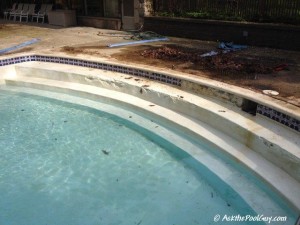Do you have a tiled pool? Tiled pools have come a long way in recent years. You can find everything from your standard blue square tiles to eccentric designs and sea life artwork created entirely from tiles. Tiled pools tend to stay in great shape and last a long time. But what do you do when you begin to see signs of age?
Your Tile is Falling Off:
 This is not exactly a sign of age, but probably a sign of bad bonding or freeze/thaw cycle issues. You could try to look behind the tile for horizontal cracks in the mud (a large horizontal crack behind your tile may indicate beam shear). There could be an issue with your caulking causing water to run behind the tile and potentially freeze (this is why the expansion joint between your coping and pool patio should always be filled in with caulk). This could cause the tile to fall off. You can temporarily regrout the tile back into place. We would recommend using a waterproof tile grout or thinset mortar cement.
This is not exactly a sign of age, but probably a sign of bad bonding or freeze/thaw cycle issues. You could try to look behind the tile for horizontal cracks in the mud (a large horizontal crack behind your tile may indicate beam shear). There could be an issue with your caulking causing water to run behind the tile and potentially freeze (this is why the expansion joint between your coping and pool patio should always be filled in with caulk). This could cause the tile to fall off. You can temporarily regrout the tile back into place. We would recommend using a waterproof tile grout or thinset mortar cement.
Your Tile Has White Deposits:
This is not harmful in anyway, just unpleasant to the design and overall look of your pool. The white spots are most likely mineral salt deposits such as calcium or magnesium. It can come out of the grout or mud and deposit on the front of the tile. Sometimes it even originates from the pool water. It can be scraped off or rinsed off with some form of an acid wash.
Your Tile is Cracking:
This could be caused by a cracked bond beam, or freezing as stated above. No need to fear. Remove the cracked tiles and replace. It is always good to find the root of the problem to keep it from reoccurring.
Tile replacement can be completed by you or you can hire a professional to do it. Either way, it is not something that should be ignored! Damaged tiles could be a sign of a larger issue such as Beam Shear– catch it while you can.
